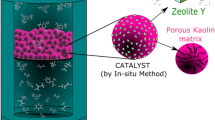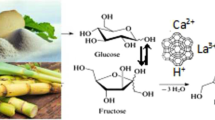Abstract
A number of biporous granulated acid faujasite-type zeolite-containing catalysts based on Ukrainian kaolin were in situ synthesized. The samples were characterized using XRF, XRD, FTIR, ammonia TPD, pyridine adsorption with IR control, and low-temperature nitrogen adsorption/desorption. The samples possess non-identical micro- and mesoporosity as well as weak, medium, and strong acid sites of different nature (Brønsted and Lewis sites). The activity of composite nanostructured zeolite materials in glucose transformation into 5-hydroxymethylfurfural was determined. A range of studies at different temperatures and reaction times using factor planning methods were conducted on the best catalyst. A full factorial experiment with two independent variables at two levels (temperature and reaction time) was implemented. According to the results of experimental data processing, the regression equation in the coded values of variables has been obtained. Response surfaces for the yields of 5-hydroxymethylfurfural and light reaction products were built. The influence of peculiarities of porosity and strength of zeolite acid sites on the activity and selectivity of the catalysts in 5-hydroxymethylfurfural synthesis is discussed. The selectivity of zeolite-containing catalysts for 5-hydroxymethylfurfural is suggested to increase with an increasing proportion of acid sites of medium strength. Weak acid centers promote the oligomerization of both the original glucose and transformation products, while strong acid sites convert glucose into lighter than 5-hydroxymethylfurfural products. The acidity of the catalysts was found to have a greater impact on the efficiency of large-porous faujasite catalysts than developed mesoporosity. Improved mesoporosity of catalysts enhances better desorption of reaction products, and as a result, the extent of catalyst deactivation decreases.












Similar content being viewed by others
References
Alver BE, Sakizci M, Yörükoğullari E (2010) Investigation of clinoptilolite rich natural zeolites from Turkey: a combined XRF, TG/DTG, DTA and DSC study. J Therm Anal Calorim 100:19–26. https://doi.org/10.1007/s10973-009-0118-0
Breck DW (1974) Zeolitic molecular sieves: structure, chemistry and use. Wiley & Sons, New York
Choudhary V, Mushrif SH, Ho C, Anderko A, Nikolakis V, Marinkovic NS, Frenkel AI, Sandler SI, Vlachos DG (2013) Insights into the interplay of Lewis and Brønsted acid catalysts in glucose and fructose conversion to 5-(hydroxymethyl)furfural and levulinic acid in aqueous media. J Am Chem Soc 135(10):3997–4006
Chen N, Zhu Z, Ma H, Liao W, Lü H (2020) Catalytic upgrading of biomass-derived 5-hydroxymethylfurfural to biofuel 2,5-dimethylfuran over Beta zeolite supported non-noble Co catalyst. Mol Catal 486:110882. https://doi.org/10.1016/j.mcat.2020.110882
Cui JL, Tan JJ, Deng TS, Cui XJ, Zhu YL, Li YW (2016) Conversion of carbohydrates to furfural via selective cleavage of the carbon-carbon bond: the cooperative effects of zeolite and solvent. Green Chem 18:1619–1624. https://doi.org/10.1039/C5GC01948F
Cui M, Wu ZJ, Huang RL, Qi W, Su RX, He ZM (2018) Integrating chromium-based ceramic and acid catalysis to convert glucose into 5-hydroxymethylfurfural. Renew Energy 125:327–333. https://doi.org/10.1016/j.renene.2018.02.085
Esteban J, Yustos P, Ladero M (2018) Catalytic Processes from biomass-derived hexoses and pentoses: a recent literature overview. Catalysts 8:637–678. https://doi.org/10.3390/catal8120637
Garber JD, Jones RE (1960) Production of 5-hydroxymethylfurfural: pat. application US2929823A: C07D307/46, N 2929823A; 26.11.1956; Publ. 22.03.1960
Karge HG (1998) Characterization by infrared spectroscopy. Micropor Mesopor Mater 22:547–549. https://doi.org/10.1016/S1387-1811(98)80021-8
Kläusli T (2014) AVA Biochem: commercialising renewable platform chemical 5-HMF. Green Process Synth 3:235–236
Kondo JN, Nishitani R, Yoda E, Yokoi T, Tatsumi T, Domen KA (2010) Comparative IR characterization of acidic sites on HY zeolite by pyridine and CO probes with silica–alumina and γ-alumina references. Phys Chem Chem Phys 12:11576–11586
Król M, Koleżyński A, Mozgawa W (2021) Vibrational spectra of zeolite Y as a function of ion exchange. Molecules 26(2):342. https://doi.org/10.3390/molecules26020342
Kuster BFM (1990) 5-Hydroxymethylfurfural (HMF). A review focussing on its manufacture. Starch - Stärke 42:314–321
Lanzafame P, Barbera K, Papanikolaou G, Perathoner S, Centi G, Migliori M, Catizzone E, Giordano G (2018) Comparison of H+ and NH4+ forms of zeolites as acid catalysts for HMF etherification. Catal Today 304:97–102. https://doi.org/10.1016/j.cattod.2017.08.004
Li Y, Meng X, Luo R, Zhou H, Lu S, Yu S, Bai P, Guo X, Lyu J (2022) Aluminum/Tin-doped UiO-66 as Lewis acid catalysts for enhanced glucose isomerization to fructose. Appl Catal a: Gen 632:118501. https://doi.org/10.1016/j.apcata.2022.118501
Liu Y, Li Z, Yang Y, Houb Y, Wei Z (2014) A novel route towards high yield 5-hydroxymethylfurfural from fructose catalyzed by a mixture of Lewis and Brönsted acids. RSC Adv 4:42035–42038. https://doi.org/10.1039/C4RA04906C
Lukyanov DM, Vazhnova T, Cherkasov N, Casci JL, Birtill JJ (2014) Insights into Brønsted acid sites in the zeolite mordenite. J Phys Chem C 118(41):23918–23929. https://doi.org/10.1021/jp5086334
Montgomery DC (2012) Design and analysis of experiments, 8th edn. John Wiley & Sons Inc
Nibou D, Amokrane S, Mekatel H, Lebaili N (2009) Elaboration and characterization of solid materials of types zeolite NaA and Faujasite NaY echanged by zinc metallic ions Zn2+. Phys Procedia 2:1433–1440
Pande A, Niphadkar P, Pandare K, Bokade V (2018) Acid modified H-USY zeolite for efficient catalytic transformation of fructose to 5-hydroxymethyl furfural (biofuel precursor) in methyl isobutyl ketone−water biphasic system. Energy Fuels 32:3783–3791. https://doi.org/10.1021/acs.energyfuels.7b03684
Parveen F, Upadhyayula S (2017) Efficient conversion of glucose to HMF using organocatalysts with dual acidic and basic functionalities—a mechanistic and experimental study. Fuel Process Technol 162:30–36. https://doi.org/10.1016/j.fuproc.2017.03.021
Patrylak L (1999) Chemisorption of the Lewis Bases on zeolites – a new interpretation of the results. Adsorp Sci Technol 17(2):115–123. https://doi.org/10.1177/026361749901700205`
Patrylak L (2000) Chemisorption and the distribution of acid Y zeolite cumene cracking products. Adsorp Sci Technol 18(5):399–408. https://doi.org/10.1260/0263617001493512
Patrylak KI, Patrylak LK, Taranookha OM (2000) Oscillatory adsorption as the determinant of the fluctuating behaviour of different heterogeneous systems. Adsorp Sci Technol 18:15–25. https://doi.org/10.1260/0263617001493242
Patrylak L, Likhnyovskyi R, Vypyraylenko V, Leboda R, Skubiszewska-Zięba J, Patrylak K (2001) Adsorption properties of zeolite-containing microspheres and FCC catalysts based on Ukrainian Kaolin. Adsorp Sci Technol 19:525–540. https://doi.org/10.1260/0263617011494376
Patrylak LK, Yakovenko AV (2021) Alkylation of isobutane with butenes under microcatalytic conditions in pulse regime. Voprosy Khimii i Khimicheskoi Tekhnologii. 1:55–61. https://doi.org/10.32434/0321-4095-2021-134-1-55-61
Patrylak LK, Pertko OP, Povazhnyi VA, Yakovenko AV, Konovalov SV (2021a) Evaluation of nickel-containing zeolites in the catalytic transformation of glucose in an aqueous medium. Appl Nanosci 12:869–882. https://doi.org/10.1007/s13204-021-01771-1
Patrylak L, Konovalov S, Pertko O, Yakovenko A, Povazhnyi V, Melnychuk O (2021b) Obtaining glucose-based 5-hydroxymethylfurfural on large-pore zeolites. Eastern-Eur J Enterprise Technol 2(110):38–44
Phung TK, Busca G (2015) On the Lewis acidity of protonic zeolites. Appl Catal a: Gen 504:151–157. https://doi.org/10.1016/j.apcata.2014.11.031
Pienkoss F, Ochoa-Hernandez C, Theyssen N, Leitner W (2018) Kaolin: a natural low-cost material as catalyst for isomerization of glucose to fructose. ACS Sustain Chem Eng 6:8782–8789. https://doi.org/10.1021/acssuschemeng.8b01151
Rouqerol F, Rouqerol J, Sing K (1999) Adsorption by powders and porous solids: principles, methodology and applications. Academic Press, San Diego
Saravanamurugan S, Riisager A, Taarning E, Meier S (2016) Combined function of bronsted and lewis acidity in the zeolite-catalyzed isomerization of glucose to fructose in alcohols. ChemCatChem 8:3107–3111. https://doi.org/10.1002/cctc.201600783
Somerset VS, Petrik LF, White RA, Klink MJ, Key D, Iwuoha E (2004) The use of X-ray fluorescence (XRF) analysis in predicting the alkaline hydrothermal conversion of fly ash precipitates into zeolites. Talanta 64(1):109–114. https://doi.org/10.1016/j.talanta.2003.10.059
Swift D, Nguyen H, Anderko A, Nikolakis V, Vlachos DG (2015) Tandem Lewis/Brønsted homogeneous acid catalysis: conversion of glucose to 5-hydoxymethylfurfural in an aqueous chromium(III) chloride and hydrochloric acid solution. Green Chem 7:4725–4735. https://doi.org/10.1039/c5gc01257k
Tosi I, Riisager A, Taarning E, Jensen PR, Meier S (2018) Kinetic analysis of hexose conversion to methyl lactate by Sn-Beta: effects of substrate masking and of water. Catal Sci Technol 8:2137–2145. https://doi.org/10.1039/C8CY00335A
Treacy MMJ and Higgins JB (2001) Collection of Simulated XRD Powder Patterns for Zeolites: 4th Revised Edition. ELSEVIER Amsterdam - London - New York - Oxford - Paris - Shannon – Tokyo
Van Bokhoven JA, Lee T-L, Drakopoulos M, Lamberti C, Thieß S, Zegenhagen J (2008) Determining the aluminium occupancy on the active T-sites in zeolites using X-ray standing waves. Nat Mater 7:551–555. https://doi.org/10.1038/nmat2220
Van Putten R-J, Van der Waal JC, De Jong E, Rasrendra CB, Heeres HJ, de Vries JG (2013) Hydroxymethylfurfural, a versatile platform chemical made from renewable resources. Chem Rev 113:1499–1597. https://doi.org/10.1021/cr300182k
Wei WQ, Wu SB (2018) Experimental and kinetic study of glucose conversion to levulinic acid in aqueous medium over Cr/HZSM-5 catalyst. Fuel 225:311–321. https://doi.org/10.1016/j.fuel.2018.03.120
Weitkamp J, Hunger M (2007) Acid and base catalysis on zeolites. In: Cejka J, Van Bekkum H, Corma A, Schueth F (eds) Introduction to zeolite molecular sieves. Elsevier, pp 787–836
Yakovenko AV, Patrylak LK, Manza IA, Patrylak KI (2000) Study of the acidity of zeolite alkylation catalysts by temperature programmed ammonia desorption. Theor Exp Chem 36:228–230. https://doi.org/10.1007/BF02522757
Zhang LX, Xi GY, Chen Z, Jiang D, Yu HB, Wang XC (2017) Highly selective conversion of glucose into furfural over modified zeolites. Chem Eng J 307:868–876. https://doi.org/10.1016/j.cej.2016.09.001
Zhang X, Hewetson BB, Mosier NS (2015) Kinetics of maleic acid and aluminum chloride catalyzed dehydration and degradation of glucose. Energy Fuels 29:2387–2393. https://doi.org/10.1021/ef502461s
Acknowledgements
The publication contains the results of studies conducted by grant from the National Research Foundation of Ukraine project 2020.01/0042.
Author information
Authors and Affiliations
Corresponding author
Ethics declarations
Conflict of interest
The corresponding author declares that there is no conflict of interest on behalf of all authors.
Additional information
Publisher's Note
Springer Nature remains neutral with regard to jurisdictional claims in published maps and institutional affiliations.
Rights and permissions
Springer Nature or its licensor holds exclusive rights to this article under a publishing agreement with the author(s) or other rightsholder(s); author self-archiving of the accepted manuscript version of this article is solely governed by the terms of such publishing agreement and applicable law.
About this article
Cite this article
Patrylak, L.K., Konovalov, S.V., Yakovenko, A.V. et al. Micro–mesoporous kaolin-based zeolites as catalysts for glucose transformation into 5-hydroxymethylfurfural. Appl Nanosci 13, 4795–4808 (2023). https://doi.org/10.1007/s13204-022-02620-5
Received:
Accepted:
Published:
Issue Date:
DOI: https://doi.org/10.1007/s13204-022-02620-5




